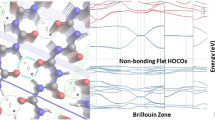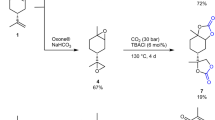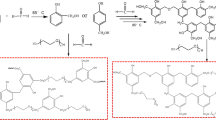Abstract
Hydroxy-tethered platinum(II) complexes were synthesized and used as diol monomers for polyurethane synthesis. Polyurethanes with moderate molecular weights were obtained by conventional polyaddition with a diisocyanate. The polyurethane containing the platinum(II) complex substituted with t-Bu groups was soluble in common organic solvents, including CHCl3 and tetrahydrofuran. Segmented polyurethanes containing platinum(II) complex moieties were also synthesized using polytetrahydrofuran and 1,4-butanediol. These polyurethanes showed good elastic properties. The nonsegmented polyurethane exhibited distinguishable photoluminescence changes upon grinding in the solid state, while the segmented polyurethanes did not.
This is a preview of subscription content, access via your institution
Access options
Subscribe to this journal
Receive 12 print issues and online access
$259.00 per year
only $21.58 per issue
Buy this article
- Purchase on Springer Link
- Instant access to full article PDF
Prices may be subject to local taxes which are calculated during checkout







Similar content being viewed by others
References
Imato K, Otsuka H. Reorganizable and stimuli-responsive polymers based on dynamic carbon–carbon linkages in diarylbibenzofuranones. Polymer. 2018;137:395–413.
Calvino C, Neumann L, Weder C, Schrettl S. Approaches to polymeric mechanochromic materials. J Polym Sci Part A: Polym Chem. 2017;55:640–52.
Herbert KM, Schrettl S, Rowan SJ, Weder C. 50th anniversary perspective: solid-state multistimuli, multiresponsive polymeric materials. Macromolecules. 2017;50:8845–70.
Sagara Y, Yamane S, Mitani M, Weder C, Kato T. Mechanoresponsive luminescent molecular assemblies: an emerging class of materials. Adv Mater. 2016;28:1073–95.
Ciardelli F, Ruggeri G, Pucci A. Dye-containing polymers: methods for preparation of mechanochromic materials. Chem Soc Rev. 2013;42:857–70.
Lee CK, Davis DA, White SR, Moore JS, Sottos NR, Braun PV. Force-induced redistribution of a chemical equilibrium. J Am Chem Soc. 2010;132:16107–11.
Davis DA, Hamilton A, Yang J, Cremar LD, Van Gough D, Potisek SL, et al. Force-induced activation of covalent bonds in mechanoresponsive polymeric materials. Nature. 2009;459:68–72.
Lu Y, Aoki D, Sawada J, Kosuge T, Sogawa H, Otsuka H, et al. Visualization of the slide-ring effect: a study on movable cross-linking points using mechanochromism. Chem Commun. 2020;56:3361–64.
Ishizuki K, Oka H, Aoki D, Goseki R, Otsuka H. Mechanochromic polymers that turn green upon the dissociation of diarylbibenzothiophenonyl: the missing piece toward rainbow mechanochromism. Chem Eur J. 2018;24:3170–73.
Imato K, Kanehara T, Nojima S, Ohishi T, Higaki Y, Takahara A, et al. Repeatable mechanochemical activation of dynamic covalent bonds in thermoplastic elastomers. Chem Commun. 2016;52:10482–85.
Oka H, Imato K, Sato T, Ohishi T, Goseki R, Otsuka H. Enhancing mechanochemical activation in the bulk state by designing polymer architectures. ACS Macro Lett. 2016;5:1124–27.
Imato K, Irie A, Kosuge T, Ohishi T, Nishihara M, Takahara A, et al. Mechanophores with a reversible radical system and freezing-induced mechanochemistry in polymer solutions and gels. Angew Chem Int Ed. 2015;54:6168–72.
Sagara Y, Traeger H, Li J, Okado Y, Schrettl S, Tamaoki N, et al. Mechanically responsive luminescent polymers based on supramolecular cyclophane mechanophores. J Am Chem Soc. 2021;143:5519–25.
Traeger H, Sagara Y, Kiebala DJ, Schrettl S, Weder C. Folded perylene diimide loops as mechanoresponsive motifs. Angew Chem Int Ed. 2021;60:16191–99.
Xue P, Ding J, Wang P, Lu R. Recent progress in the mechanochromism of phosphorescent organic molecules and metal complexes. J Mater Chem C. 2016;4:6688–706.
Wenger OS. Vapochromism in organometallic and coordination complexes: chemical sensors for volatile organic compounds. Chem Rev. 2013;113:3686–733.
Zhang X, Chi Z, Zhang Y, Liu S, Xu J. Recent advances in mechanochromic luminescent metal complexes. J Mater Chem C. 2013;1:3376–90.
Ito H, Muromoto M, Kurenuma S, Ishizaka S, Kitamura N, Sato H, et al. Mechanical stimulation and solid seeding trigger single-crystal-to-single-crystal molecular domino transformations. Nat. Commun. 2013;4:2009.
Seki T, Ozaki T, Okura T, Asakura K, Sakon A, Uekusa H, et al. Interconvertible multiple photoluminescence color of a gold(I) isocyanide complex in the solid state: solvent-induced blue-shifted and mechano-responsive red-shifted photoluminescence. Chem Sci. 2015;6:2187–95.
Ito H, Saito T, Oshima N, Kitamura N, Ishizaka S, Hinatsu Y, et al. Reversible mechanochromic luminescence of [(C6F5Au)2(μ-1,4-diisocyanobenzene)]. J Am Chem Soc. 2008;130:10044–45.
Lien C-Y, Hsu Y-F, Liu Y-H, Peng S-M, Shinmyozu T, Yang J-S. Steric engineering of cyclometalated Pt(II) complexes toward high-contrast monomer–excimer-based mechanochromic and vapochromic luminescence. Inorganic Chem. 2020;59:11584–94.
Norton AE, Abdolmaleki MK, Liang J, Sharma M, Golsby R, Zoller A, et al. Phase transformation induced mechanochromism in a platinum salt: a tale of two polymorphs. Chem Commun. 2020;56:10175–78.
Choi SJ, Kuwabara J, Nishimura Y, Arai T, Kanbara T. Two-step changes in luminescence color of Pt(II) complex bearing an amide moiety by mechano- and vapochromism. Chem Lett. 2011;41:65–67.
Nishiuchi Y, Takayama A, Suzuki T, Shinozaki K. A polymorphic platinum(II) complex: yellow, red, and green polymorphs and X-ray crystallography of [Pt(fdpb)Cl] [Hfdpb = 1,3-bis(5-trifluoromethyl-2-pyridyl)benzene]. Eur J Inorg Chem. 2011;2011:1815–23.
Abe T, Itakura T, Ikeda N, Shinozaki K. Luminescence color change of a platinum(II) complex solid upon mechanical grinding. Dalton Trans. 2009;28:711–15.
Kang J, Zhang X, Zhou H, Gai X, Jia T, Xu L, et al. 1-D “Platinum Wire” stacking structure built of platinum(II) Diimine Bis(σ-acetylide) units with luminescence in the NIR region. Inorganic Chem. 2016;55:10208–17.
Ni J, Wang Y-G, Wang H-H, Pan Y-Z, Xu L, Zhao Y-Q, et al. Reversible dual-stimulus-responsive luminescence and color switch of a platinum complex with 4-[(2-trimethylsilyl)ethynyl]-2,2′-bipyridine. Eur J Inorg Chem. 2014;2014:986–93.
Zhang X, Wang J-Y, Ni J, Zhang L-Y, Chen Z-N. Vapochromic and mechanochromic phosphorescence materials based on a platinum(II) complex with 4-trifluoromethylphenylacetylideundefined. Inorganic Chem. 2012;51:5569–79.
Ni J, Zhang X, Wu Y-H, Zhang L-Y, Chen Z-N. Vapor- and mechanical-grinding-triggered color and luminescence switches for Bis(σ-fluorophenylacetylide) platinum(II) complexes. Chem Eur J. 2011;17:1171–83.
Geng H, Luo K, Zou G, Wang H, Ni H, Yu W, et al. New phosphorescent platinum(II) complexes: lamellar mesophase and mechanochromism. New J Chem. 2016;40:10371–77.
Ohno K, Yamaguchi S, Nagasawa A, Fujihara T. Mechanochromism in the luminescence of novel cyclometalated platinum(II) complexes with α-aminocarboxylates. Dalton Trans. 2016;45:5492–503.
Krikorian M, Liu S, Swager TM. Columnar liquid crystallinity and mechanochromism in cationic platinum(II) complexes. J Am Chem Soc. 2014;136:2952–55.
Zhang D, Wu L-Z, Yang Q-Z, Li X-H, Zhang L-P, Tung C-H. Versatile photosensitization system for 1O2-mediated oxidation of alkenes based on nafion-supported platinum(II) terpyridyl acetylide complex. Organic Lett. 2003;5:3221–24.
Li X-H, Wu LZ, Zhang LP, Tung C-H, Che C-M. Luminescence and photocatalytic properties of a platinum(II)–quaterpyridine complex incorporated in Nafion membrane. Chem Commun. 2001;7:2280–81.
Liu N, Wang Y, Wang C, He Q, Bu W. Syntheses and controllable self-assembly of luminescence platinum(II) plane–coil diblock copolymers. Macromolecules. 2017;50:2825–37.
Kumpfer JR, Taylor SD, Connick WB, Rowan SJ. Vapochromic and mechanochromic films from square-planar platinum complexes in polymethacrylates. J Mater Chem. 2012;22:14196–204.
Aoki R, Horiuchi T, Makino S, Sano N, Imai Y, Sogawa H, et al. Chirality induction in platinum-containing polyaryleneethynylenes by exchange from achiral phosphine ligands to P-chiral phosphine ligands. Polymer. 2023;265:125576.
Ishida T, Sotani T, Sano N, Sogawa H, Sanda F. Control of higher-order structures of platinum-containing conjugated polymers by ligand exchange reactions: chirality transfer from optically active ligands to optically inactive polymers. Macromolecules. 2022;55:309–21.
Makino S, Horiuchi T, Ishida T, Sano N, Yajima T, Sogawa H, et al. Synthesis of platinum-containing conjugated polymers bearing chiral phosphine ligands. study of geometries and intermolecular interactions leading to aggregation. Organometallics. 2022;41:1699–709.
Marumoto M, Sotani T, Miyagi Y, Yajima T, Sano N, Sanda F. Synthesis of platinum-containing conjugated polymers having QuinoxP* and bipyridine ligands. Chirality transfer from the phosphine ligand to the polymer backbone. Macromolecules. 2020;53:2031–38.
Sotani T, Yajima T, Sogawa H, Sanda F. Synthesis of platinum-containing conjugated polymers bearing optically active amide groups: a mechanistic study of chiral aggregation. Macromolecules. 2020;53:11077–88.
Miyagi Y, Ishida T, Marumoto M, Sano N, Yajima T, Sanda F. Ligand exchange reaction for controlling the conformation of platinum-containing polymers. Macromolecules. 2018;51:815–24.
Miyagi Y, Sotani T, Yajima T, Sano N, Sanda F. Effect of phosphine ligand on the optical absorption/emission properties of platinum-containing conjugated polymers. Polym Chem. 2018;9:1772–79.
Miyagi Y, Shibutani Y, Otaki Y, Sanda F. Synthesis of platinum-containing poly(phenyleneethynylene)s having various chromophores: aggregation and optical properties. Polym Chem. 2016;7:1070–78.
Otaki Y, Marumoto M, Miyagi Y, Hirao T, Haino T, Sanda F. Synthesis and properties of novel optically active platinum-containing poly(phenyleneethynylene)s. Chem Lett. 2016;45:937–39.
Miyagi Y, Hirao T, Haino T, Sanda F. Synthesis of optically active conjugated polymers containing platinum in the main chain: control of the higher-order structures by substituents and solvents. J Polym Sci Part A: Polym Chem. 2015;53:2452–61.
Inoue Y, Ishida T, Sano N, Yajima T, Sogawa H, Sanda F. Platinum-mediated reversible cross-linking/decross-linking of polyacetylenes substituted with phosphine ligands: catalytic activity for hydrosilylation. Macromolecules. 2022;55:5711–22.
Uchiyama S, Sotani T, Mizokuro T, Sogawa H, Wagener KB, Sanda F. End functionalization of polynorbornene with platinum–acetylide complexes utilizing a cross-metathesis reaction. Macromolecules. 2023;56:281–91.
Sotani T, Mizokuro T, Yajima T, Sogawa H, Sanda F. Highly photoluminescent poly(norbornene)s carrying platinum–acetylide complex moieties in their side chains: evaluation of oxygen sensing and TTA–UC. Polym Chem. 2021;12:4829–37.
Menon AV, Madras G, Bose S. The journey of self-healing and shape memory polyurethanes from bench to translational research. Polym Chem. 2019;10:4370–88.
Delebecq E, Pascault J-P, Boutevin B, Ganachaud F. On the versatility of urethane/urea bonds: reversibility, blocked isocyanate, and non-isocyanate polyurethane. Chem Rev. 2013;113:80–118.
Chattopadhyay DK, Raju KVSN. Structural engineering of polyurethane coatings for high performance applications. Prog Polym Sci. 2007;32:352–418.
Osaka K, Matsumoto T, Taniguchi Y, Inoue D, Sato M, Sano N. High-throughput and automated SAXS/USAXS experiment for industrial use at BL19B2 in SPring-8. AIP Conference Proceedings. 2016;1741:030003.
Sawada J, Sogawa H, Marubayashi H, Nojima S, Otsuka H, Nakajima K, et al. Segmented polyurethanes containing movable rotaxane units on the main chain: Synthesis, structure, and mechanical properties. Polymer. 2020;193:122358.
Frisch ME, Trucks G, Schlegel HB, Scuseria G, Robb M, Cheeseman J, et al. Gaussian 16. Gaussian, Inc. Wallingford, CT (2016).
Su M-M, Kang J-J, Liu S-Q, Meng C-G, Li Y-Q, Zhang J-J, et al. Strategy for achieving long-wavelength near-infrared luminescence of diimineplatinum(II) complexes. Inorganic Chem. 2021;60:3773–80.
Wong KM-C, Yam VW-W. Self-assembly of luminescent alkynylplatinum(II) terpyridyl complexes: modulation of photophysical properties through aggregation behavior. Acc Chem Res. 2011;44:424–34.
Pattanayak A, Jana SC. Thermoplastic polyurethane nanocomposites of reactive silicate clays: effects of soft segments on properties. Polymer. 2005;46:5183–93.
Ning L, De-Ning W, Sheng-Kang Y. Crystallinity and hydrogen bonding of hard segments in segmented poly(urethane urea) copolymers. Polymer. 1996;37:3577–83.
Kojio K, Nozaki S, Takahara A, Yamasaki S. Influence of chemical structure of hard segments on physical properties of polyurethane elastomers: a review. J Polym Res. 2020;27:140.
Rahmawati R, Nozaki S, Kojio K, Takahara A, Shinohara N, Yamasaki S. Microphase-separated structure and mechanical properties of cycloaliphatic diisocyanate-based thiourethane elastomers. Polym J. 2019;51:265–73.
Koberstein JT, Russell TP. Simultaneous SAXS-DSC study of multiple endothermic behavior in polyether-based polyurethane block copolymers. Macromolecules. 1986;19:714–20.
Acknowledgements
This research was financially supported by JSPS KAKENHI (Grant Number JP21K05203), the Kansai University Fund for Supporting Young Scholars, 2021. The synchrotron radiation experiments were performed at beamline BL19B2 of SPring-8 with the approval of the Japan Synchrotron Radiation Research Institute (JASRI) (Proposal 2022B1752). This research used computational resources under the Collaborative Research Program for Young Women Scientists provided by the Academic Center for Computing and Media Studies, Kyoto University. The authors thank Prof. Takashi Miyata, Prof. Akifumi Kawamura and Ms. Chika Hajime (Kansai University) for use of the tensile testing machine.
Author information
Authors and Affiliations
Corresponding authors
Ethics declarations
Conflict of interest
The authors declare no competing interests.
Additional information
Publisher’s note Springer Nature remains neutral with regard to jurisdictional claims in published maps and institutional affiliations.
Supplementary information
Rights and permissions
Springer Nature or its licensor (e.g. a society or other partner) holds exclusive rights to this article under a publishing agreement with the author(s) or other rightsholder(s); author self-archiving of the accepted manuscript version of this article is solely governed by the terms of such publishing agreement and applicable law.
About this article
Cite this article
Sogawa, H., Abe, M., Shintani, R. et al. Polyurethanes containing platinum in the main chain: synthesis, structure and mechanofluorochromism. Polym J 55, 1119–1128 (2023). https://doi.org/10.1038/s41428-023-00822-4
Received:
Revised:
Accepted:
Published:
Issue Date:
DOI: https://doi.org/10.1038/s41428-023-00822-4



